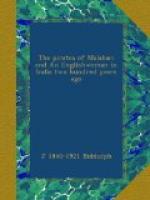The Samaritan was wrecked in the Comoro Islands; but Cobb, continuing his cruise with the Roebuck, captured two Mogul vessels at the mouth of the Red Sea, from one of which he took a large sum of money and a quantity of goods, though the vessel had a pass from the Surat factory. Again the Company’s servants at Surat were imprisoned, and not released till they had paid full compensation. Some small satisfaction was experienced when it became known that John Proud, master of the Swan, one of the Company’s ships, had encountered the Roebuck in the Comoro Islands, and had attacked the freebooter. He was unable to capture it, but succeeded in procuring restitution of the captured goods; the treasure, however, was carried off to London, where it must have seemed as if the days of Drake and Hawkins had come again.
The Company laid their grievance before the King, who expressed much concern, promising to write to the Great Mogul and explain matters; so the Company commenced an action against Bonnell and Kynaston in the Admiralty Court. Porter was too highly placed to be struck at. Bonnell evaded arrest and escaped to France, but Kynaston was arrested and lodged in gaol; upon which Charles ordered his release on bail, saying he would try the case himself at his leisure.
But Porter’s views went beyond a single piratical voyage. Hardly had Cobb started on his cruise, when he entered into partnership with Sir William Courten for an association to establish a separate trade to the East Indies. A royal grant was obtained, and the King himself was credited with a share to the nominal extent of L10,000. The grant was a flagrant breach of faith, and was the inauguration of the system of interlopers that in after years caused so much loss and trouble to the Company. Four ships were equipped and sent out, and before long it became known that two vessels from Surat and Diu had been plundered by Courten’s ships, and their crews tortured. Again the Company’s servants at Surat were seized and thrown into prison, where they were kept for two months, being only released on payment of Rs.1,70,000, and on solemnly swearing to respect Mogul ships.




